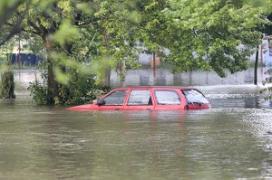Experts Discuss Climate Change and Resiliency Planning
Two experts recently spoke at Volpe on the role greenhouse gas emissions and other factors have on climate change. Current climate research indicates that more carbon means a higher average global temperature.
These talks, part of Volpe’s speaker series Transportation System Resilience, Extreme Weather, and Climate Change, provided information for transportation professionals planning how to respond to climate change and extreme weather.
Temperature Increases of “Existential” Proportions
"There is not really any dispute in my field about the relationships between CO² and the environment," said Dr. Kerry Emanuel, professor of atmospheric science at MIT, during his recent talk. According to Dr. Emanuel, our climate is generally warming and today the concern isn’t another Ice Age—it’s that someday there might be no ice at all.

Modern models estimate that the global climate could warm by as much as 4.5 degrees Celsius or even more—an increase of “existential” proportions with potentially devastating consequences, Dr. Emanuel said. Carbon dioxide concentrations began to increase much more rapidly at the dawn of the industrial era and are on track to double, triple, or possibly more, according to Dr. Emanuel.
Dr. Emanuel provided information for decision makers who are considering how best to prepare for this risk. He pointed to the U.S. Department of Defense 2014 Quadrennial Defense Review, which ranks global climate change as one of the major national security threats facing the U.S. The concern is the effects of climate change on supplies of fresh water and food.
Dr. Emanuel, whose work focuses on intense meteorological events, said higher temperatures are just the tip of the proverbial melting iceberg—extreme climate events are also becoming more common.
Impacts of Climate Change
Climate change means that dry areas become drier, wet areas become wetter, and hurricanes in the Atlantic are getting stronger (though there is not yet a direct link between higher sea temperatures and more intense hurricanes). “You start seeing temperatures you never saw before,” said Dr. Emanuel. “Hot temperatures occur much more frequently…the really cold temperatures occur far less frequently.” Drought is one of the big issues we worry about when we think about the consequences of climate change.
“There will always be weather. There will always be El Niño,” Dr. Emanuel said. “But it’s really important to distinguish the signal from the noise and you have to look at a large amount of data to see that signal.”
Somewhere between the signal and the noise lies the transportation planner. Extreme weather events like Hurricane Sandy, whose surge paralyzed swaths of the East Coast and was a 1 in 700 event, are particularly important to public transportation organizations, Dr. Emanuel said. It takes just one major storm to knock out an entire transit system, which may not recover for weeks or months, and some parts of which may take years to rebuild.
How At-Risk Communities Are Doing Resiliency Planning
 “Adaptation and resiliency are closely related, but not the same thing," said Volpe transportation planner Bill Lyons during his recent talk. "Adaptation means anticipating risks and strengthening infrastructure to resist extreme weather impacts. Resilience looks more broadly at how communities might change to survive and potentially prosper. This process may begin with adaptation but extends further to land use and other transportation strategies.”
“Adaptation and resiliency are closely related, but not the same thing," said Volpe transportation planner Bill Lyons during his recent talk. "Adaptation means anticipating risks and strengthening infrastructure to resist extreme weather impacts. Resilience looks more broadly at how communities might change to survive and potentially prosper. This process may begin with adaptation but extends further to land use and other transportation strategies.”
Although there is no simple definition for resiliency, there are useful examples of how communities at risk are beginning to do resiliency planning.
The Hampton Roads Planning District Commission in Virginia provides technical and planning assistance for its low-lying cities. It manages rising sea levels and works closely with the Navy to protect shipyards, ports, and the region’s economic base.
Lyons cited the San Francisco Bay Area Metropolitan Transportation Commission (MTC) as an “exciting example” of a planning agency working to anticipate the risks of sea level rise, and to bring these considerations into the transportation planning process. He noted that it will be interesting to see how the MTC brings climate resiliency into its evolving focus on transportation performance and measurable outcomes.
Successful Resilience Case Study Abroad
The Netherlands provides an excellent example of a successful national and local response to the risks of climate change and a broadly based approach to resiliency, according to Lyons.
Resiliency tactics include the Delta Programme, which seeks to ensure flood safety, fresh water, and plans for investments to ensure economic strength. This involves collaboration between leaders in the Netherlands and transportation agencies—cities, ports, and other transportation providers. Rotterdam is 80 percent below sea level, yet is planning to be climate-proof by 2025.
“The cities of the Netherlands are a gold standard of what resilient communities look like,” Lyons said. “The Netherlands has a long history of surviving and prospering below sea level.”
Lyons’ main point is that every transportation agency facing risks from climate change and extreme weather can begin to plan for resiliency by using the flexible transportation planning framework followed by metropolitan areas.
The framework typically begins with technical analysis of risks and vulnerabilities. Climate resilience and mitigation can be important considerations in vision or scenario plans; included as goals in the 20-year plans developed by all areas; incorporated into assessment of candidate investments; or included in performance measures for assessing the results of plans and projects.
Event Videos
Please see below for video highlights from the recent talks by Dr. Kerry Emanuel and Bill Lyons:
Resilience Planning by Communities at Risk

- San Francisco Bay Area Metropolitan Transportation Commission is an agency working to anticipate the risks of sea level rise, and to bring these considerations into the transportation planning process
- Hampton Roads Planning District Commission in Virginia provides technical and planning assistance for its low-lying cities
- The Netherlands provides an example of a successful national and local response to the risks of climate change and a broadly based approach to resiliency
